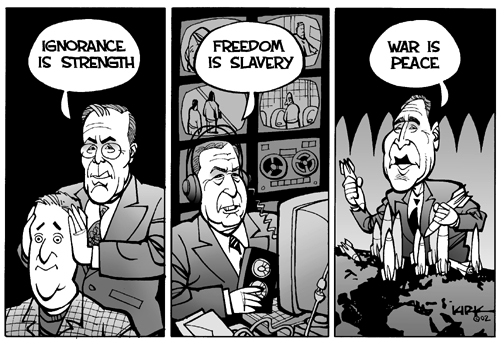 After 25 years I made my Trinity College 1991 master’s thesis on Orwell “Inside or Outside the Whale: George Orwell’s Art and Polemic” available in the college library’s Digital Repositoryaccessible directly or through Merlot This chronological study of the evolution of the works of George Orwell is helpful for the futurist, the citizen awash in groupthink, scholars of standpoint epistemology, of mind and nature, of radical humanism, and others. A former British officer and Spanish revolutionary, he became a Democratic Socialist who believed in intellectual freedom above all and was a champion of the common man. Described as the leading exemplar of the public intellectual, he focused on activism vs passivism (and pacifism), and transforming art and politics into cultural power with mind and nature as the foundation. Like few others, he understood cultural shifts and anxieties, pervasive ideologies, the dangers of ignorance, and the risks of becoming politically malleable. Inhabiting multiple cultures alternately as observer and participant he took a stand against meaninglessness, always in touch with nature. Curiously, he identified with the creative writings of libertine Henry Miller, whom he saw as a new kind of common man inside the whale of joy and sex that made him invulnerable to totalitarianism and the swindles of progress. Miller’s influence is seen in 1984, where sex was a failed revolutionary act. Words had no power as history was altered daily, and daily war on the telescreen fed constant fear, so the characters were swallowed up by the passions of the moment. We need the inspiration of “the crystal spirit” with all his decency and insight as distractions abound in our global sandstorm of words and images, where fact and fiction are often dangerously synonymous, unbeknownst.
After 25 years I made my Trinity College 1991 master’s thesis on Orwell “Inside or Outside the Whale: George Orwell’s Art and Polemic” available in the college library’s Digital Repositoryaccessible directly or through Merlot This chronological study of the evolution of the works of George Orwell is helpful for the futurist, the citizen awash in groupthink, scholars of standpoint epistemology, of mind and nature, of radical humanism, and others. A former British officer and Spanish revolutionary, he became a Democratic Socialist who believed in intellectual freedom above all and was a champion of the common man. Described as the leading exemplar of the public intellectual, he focused on activism vs passivism (and pacifism), and transforming art and politics into cultural power with mind and nature as the foundation. Like few others, he understood cultural shifts and anxieties, pervasive ideologies, the dangers of ignorance, and the risks of becoming politically malleable. Inhabiting multiple cultures alternately as observer and participant he took a stand against meaninglessness, always in touch with nature. Curiously, he identified with the creative writings of libertine Henry Miller, whom he saw as a new kind of common man inside the whale of joy and sex that made him invulnerable to totalitarianism and the swindles of progress. Miller’s influence is seen in 1984, where sex was a failed revolutionary act. Words had no power as history was altered daily, and daily war on the telescreen fed constant fear, so the characters were swallowed up by the passions of the moment. We need the inspiration of “the crystal spirit” with all his decency and insight as distractions abound in our global sandstorm of words and images, where fact and fiction are often dangerously synonymous, unbeknownst.
Here is a link to a documentary on Orwell on the Internet Archive.
